|
|
|
Mid-Summer Greetings to all readers,
Well, maybe not quite "mid-summer"!
Today is Tanabata, the 7th day of the 7th month, a day on which a major festival is held in two cities in Japan, Hiratsuka about an hour and change south of Tokyo, and Sendai, up in Miyagi Prefecture in Tokyo. Sendai is a much larger city, and Hiratsuka gets so crowded it can take 30 minutes or more just to get out of the train station building.
What does Tanabata celebrate? Why, seven-minute abs, of course!
Actually, not. It is about two stars, separated by the Milky Way, that are permitted to meet once a year, on this day. Much more can be learned with a quick search, but this is the long and short of it.
Enjoy Tanabata, preferably with seven friends, and/or seven (smallish) glasses of sake.
And please enjoy the newsletter as well!
John Gauntner
~~~~~~~~~~~~~~~~~~~~~~~~~~~~~~~~~~~~~~~~~~~~~~~~~~~~~~~
Sake Confidential - Now available
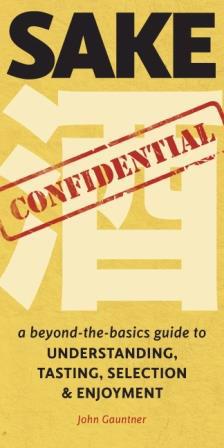 |
|
I am pleased to also announce that my mosr recent book - my sixth - is
now available. Sake Confidential is a beyond-the-basics guide to the sake world, and after a short introductory chapter on all things sake, it goes into depth on many topics not usually touched upon.
Sake Confidential is a practical and concise yet complete guide to sake idiosyncrasies, misperceptions, and controversies presented in a conversational and informal tone. Easy to read and frank, it also includes sake recommendations tied into each of the topics presented.
You can get yours here at Amazon. But that is just one venue! Barnes and Noble, for one, carries it in its bricks-and-mortar stores as well.
You can also register for a chance to win a free copy here! You may have to wait a bit though to get it. But that fun option is available as well.
Not sure if this is for you yet? Well, just read this review. Thanks to Richard Auffrey for that one. Or this one. Thanks to Domenic for that one.
|
|
Just What is a
"Nishiki" Anyway?
What is behind the names of many rice types?
There are, at present, perhaps 100 varieties of sake rice out there. A few new ones are born (crossbred) each year, and a few fall out of production, and therefore out of official existence. And of those 100, a disproportionately high number have the character for “nishiki” (pronounced closer to
neeshki) in the name.
There is of course the most famous, Yamada Nishiki. But also there are Miyama Nishiki, Hattan Nishiki, Oyama Nishiki, Kinmon Nishiki, Saka Nishiki, Toyo Nishiki and even Hakutsuru Nishiki. Then there is Misato Nishiki, Kita Nishiki, Senbon Nishiki, Tosa Nishiki, Yume Nishiki, and yet a few more nishikis out there as well. You probably get the point by now. Interestingly, this character does not make an appearance in eating rice, just in sake rice. At least, as far as I can ascertain things.
So, just what is a nishiki anyway, and what is it doing in our sake rice?
 |
|
The most commonly found translation in Japanese-to-English dictionaries
is “brocade.” Okay. Fine. But that doesn’t really help much either. I mean, what, really, is a brocade? A similarly typical dictionary check resulted in this: “A class of richly decorative shuttle-woven fabrics, often made in colored silks and with or without gold and silver threads.” Oh; okay. That helped.
To me, a brocade is a beautiful cloth or tapestry hung on the wall, usually with some meaning involved in it – like, it represents something or has a story behind it. Kind of like a tapestry but richer in appearance. I learned a lot more about brocades in researching this, but never found out why they might be in so many sake rice names. But then I met a farmer who is also sake brewer.
Yuichi Hashiba is his name, and his brewery is Izumibashi Shuzo of Kanagawa, brewing a sake called Izumibashi. And he explained it.
Rice is planted sometime between April and June, and harvested sometime between August and October. Most
sake rice is planted later and harvested later than most eating rice. Most, that is. But when harvest time comes around, be that August, September or October, one can stand on the edge of expansive rice fields and look out on the golden ears of rice that hang over in their ripeness, awaiting the sickle. Or a combine, which is more often the case these days.
When I visited Hashiba-san last fall, we strolled out on narrow lanes separating fields of Omachi, Yamada Nishiki, and Kame-no-o.
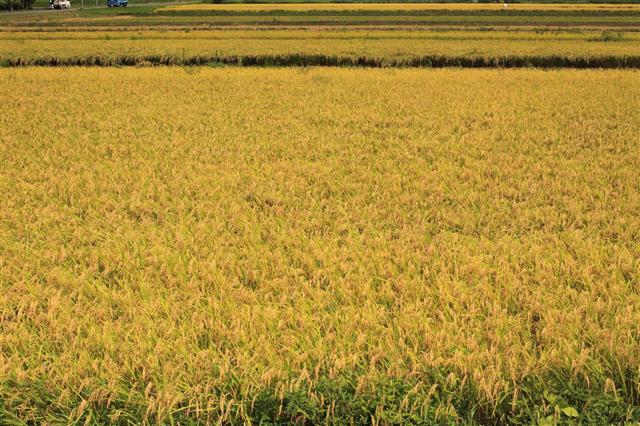 |
|
“Look out at all that,” he began. “See that beautiful golden expanse of sake rice? Look at all those hanging ears! Duddn’it all just tell a story? Duddn’it look like something you could hang on a wall as a show of glory and success?” You could see by the passion in his eyes that he indeed meant it.
And as we gazed out upon these acres of golden ears of rice bending in anticipation, the wind blew, causing the whole scene to move in undulating, golden waves. It looked like… well, like a brocade of rice surging and swelling in gentle waves. It looked like a nishiki, actually.
All it took was one explanation with a rice farmer / sake brewer as we stood in the evening at the edge of his fields on an October evening as the wind gently blew. It was clear why so many sake rice types have the character for brocade in their names.
Being early July, it is still a couple-few months before we can see this again. But it is a beautiful scene, and one that will remind us when we see it that the next sake-brewing season is, again, just around the corner.
|
|
Sake Yeast Shake-out
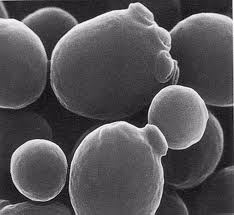 |
|
Sake yeast choices are an interesting – if frustrating – topic of study. I have covered them many times in the past in this newsletter, should you be interested in perusing the archives and even older back issues.
In short, yeast converts sugar to alcohol, and the choice of yeast leads to varying aromas – among other things, most notably acidity. There are many other things behind the choice of yeast, including robustness of fermentation, tolerance to alcohol, preferred temperature range and more.
Studying yeast types is interesting since they do have tendencies that we can learn to pick out. It is frustrating because there are many types, with countless variations and mutations, and they are blended all the time too. It all gets hard to follow! But if we can maintain our sense of humor, it continues to be worth it and fun.
These days there are many sources for yeast, but the classic source for the classic yeasts is the Nihon Jouzou Kyoukai, or the Brewing Society of Japan, a research organization that makes great yeast in pure form available to brewers.
Back about 80 years ago when this organization was put together, they started to reproduce yeast that was known to be strong and predictable, and make it available to any brewer in the industry in little ampules. This helped ensure good sake, which led to good tax revenue. ;-)
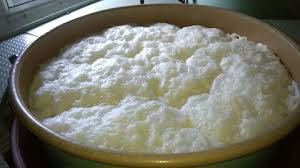 |
|
They started, naturally enough, with what they called Yeast Number 1. Next came Yeast Number 2, and so on. These days, they are up to Number 19, although there are a handful that do not follow this simple numbering convention. The yeasts distributed by this organization are collectively referred to as “Kyoukai Kobo,” or “Association Yeasts.”
But the first five fell out of comparative disuse, as did many of the more recently developed strains. In fact, there seems to have been shake-out amongst these yeasts, to the point that the only ones we see on a large scale are #6, #7, #9, #14, and #18-01. (Number 19-01 is only recently developed and has not had a chance to make its presence felt in the industry.) The others have all but disappeared. Not totally, mind you, but they are much less commonly seen.
Number 6 was developed at Aramasa in Akita, a brewery that is now making the most of that yeast and is massively popular, and deservedly so. Number 7 was developed at Masumi in Nagano, where it is also used with great success. However, ole’ 7 was erstwhile the most commonly used yeast for regular sake in the country. It still may be!
Number 9 was developed at Koro in Kumamoto, and while more ginjo-esque than its predecessors, it now may be giving Number 7 a run for the money in how commonly it is used.
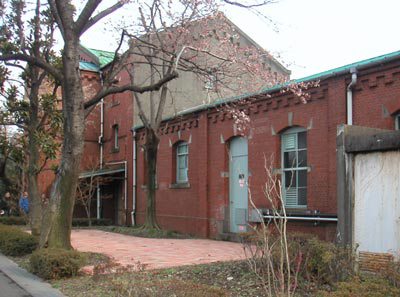 |
|
Number 14 is more recently developed, in the last twenty years, and while popular in some regions - in particular those in the center of the country, close to Kanazawa in Ishikawa were it was developed - is not all that widely used. And newcomer (comparatively) Number 18-01 is growing in popularity for daiginjo sake, much as Number 9 did twenty or so years ago. (Note, the -01 just means it is a non-foaming version of the regular yeast. So Number 18-01 is really Number 18 that does not foam up so much. But this is a topic for another time!)
So, what’s the difference? What might you need to remember? In its simplest essence, bear this in mind: the higher the number, the fruiter the aromas, and the lower the acidity. So, Number 6 has a solid acidity and not much fruit. Number 1801 is much softer due to lower acidity, but much fruitier as well.
Is it really that simple? Of course not. Nothing is, especially in the sake world. But that general rule of thumb will serve you well, and you can stick it in your back pocket when you go out drinking sake.
 |
|
Also, while not mentioned above, Yeast Number 10 is an interesting topic. It is basically a descendent of a family of yeast strains known as Meiri, developed by a company, Meiri Shurui, brewers of a sake called Fuku Shobun, in Ibaraki Prefecture. The straight Meiri yeasts are massively aromatic and popular, and as such, the ancestors, relatives and descendants (remember, yeast generations are very short!) of this yeast are much, much more common than the actual Number 10 itself. In fact, it is hard to define what a Number 10 tastes and smells like, in my experience anyway, since it so hard to come upon one that is pure anymore.
Of course, there is much tinkering going on. Many brewers had what was once a Number 9, as just one example, but now has mutated and changed to be something else. But they still might call it Number 9. Which is fine!
 |
|
Also, there are countless other yeasts, developed by various research centers or naturally occurring in breweries. Tons of ‘em. Oodles and oodles of ‘em. And they are blended in myriad ways on top of all of that.
Hence aforementioned frustration, and aforementioned fun.
But when it comes to the Association Yeasts, the classics, which still arguably are used in most of the sake in the industry, we’re down to Numbers 6, 7, 9, 14 and 1801 as the main ones, i.e. “the usual suspects.” And remember the higher number, the more the fruit, and the lower the acidity. It’s a great rule of thumb that will only add to your enjoyment of sake.
|
 Announcements and Events Announcements and Events
Sake Professional Course in the US
August, 2014
Amazingly, this course has all but filled up via word of mouth alone. If you are interested in attending, please let me know asap, as there is a short waiting list.
The next Sake Professional Course will be held in Chicago Ill in
August, specifically, August 12 - 14 at the restaurant Sunda in Chicago. If you are interested in attending, by all means please contact me by email. The next one is tentatively scheduled for December in San Francisco.
The Sake Professional Course will of course include certification testing for the Sake Education Council-backed Certified Sake Professional exam.
~~~~~~~~~~~~~~~~~~~~
Sake Education Council Website
Please take a moment to check out the website for the Sake Education Council, the organization behind the Certified Sake Professional and Advanced Sake Professional certifications. We plan to grow steadily, strongly and continually, and we will need the support of all those that love sake to do so. Follow us through the "usual suspects" of social media.
Don't forget the archives!
Older editions of this newsletter are archived here.
Really old editions are archived here.
|
 Sake Education Central Sake Education Central
Sake's Hidden Stories and The Sake Notebook are now available for the Kindle, Nook and iBooks!
The Sake Notebook is now available for the Kindle as well as the Nook. And now, it is available for iBooks on iTunes as well!
Sake's Hidden Stories too is now availabe on the Kindle as well as the Nook. And now, it is available for iBooks on iTunes as well!
Both are
less expensive than their original pdf version too. Now is your chance to learn more about sake from your phone or tablet! Check 'em out!
Sake Dictionary App for the iPhone, iPod and iPad
"For 99 cents, this app ROCKS!!"
-a satisfied customer
There you are, perusing a menu, or standing in front of a shelf of great sake, or perhaps reading a sake newsletter… and up pops one of those hairy, pesky sake terms in Japanese. You know you have heard it many times, but dammit, you just cannot remember what it means now…
No problem! Just whip out your iPhone or iPod and fire up your trusty old version of
The Sake Dictionary. In a matter of seconds, you’ll be amongst the cognoscenti once again. But… if only you could pronounce it properly. Now that would really rock!
Done! Just tap on the term and you will hear a clear example of how to pronounce the term in Japanese. Repeat it a couple of times and the term is yours for eternity, to toss about and impress your mates.
What’s more, it’s
less!
Less than what it cost before, much less. Like less than one-seventh less. For a limited time only, the audio-enhanced version of The Sake Dictionary iPhone app is available for a mere $0.99.
|
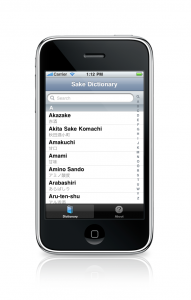 |
|
|
The Sake Dictionary is a concise little package of all the terms you might ever come across when dealing with sake. Almost 200 of them - including sake grades, rice variety names, seasonal sake terms, special varieties, rare types, post-brewing processing words and the myriad terms used in sake production - many of which are not even familiar to the average Japanese person on the street - are listed up here with concise, useful and clear definitions and the written Japanese version as well. And now, with the new audio component, you can listen and learn just how to pronounce those terms properly.
Start to toss around Japanese sake terms like you were raised knowing them! Gain a level of familiarity hitherto unimaginable! Avoid frustrating paralysis when faced with a sake-related purchase!
Get your copy of The Sake Dictionary now and never be confused by sake terms - or how to pronounce them - again.
Get it here: http://itunes.com/apps/sakedictionary
(Note if you have already purchased it, this upgrade to the audio version is free. Just go to iTunes and get it!)
|
Are you not getting this newsletter? I realize that is like asking that
"those not present please raise your hand," but for future reference, should you spontaneously stop receiving this newsletter, please go here and sign up again. Should that not work, please go to www.sake-world.com.
Email newsletter services are very careful not to be considered spam enablers, but the problem is that often very valid email addresses come back bounced as invalid. It is an unavoidable problem. So if you or someone you know is not getting this, or stop(s) receiving it inexplicably, please do take a moment to double check that you are still subscribed.
Sincere apologies for the hassle, mixed with gratitude for reading this newsletter. |
I hope you have found the above information helpful and entertaining. For more information about all things sake, please check out www.sake-world.com. Until next month, warm regards, and enjoy your sake.
Questions and comments should be directed to John Gauntner, at this
email address.
All material Copyright, John Gauntner & Sake World Inc.
Regards,
John Gauntner
Sake World, Inc
 . . 
|
|
